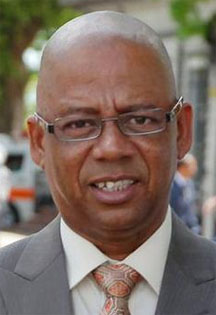Guyana and Suriname have agreed to work to tighten security and regularise the “backtrack” route used by many persons to travel between the two countries.
“We know that there are some security issues that has to be taken care of, that’s why we have decided that technical people from the security institutions from both our countries should meet as soon as possible to discuss the issue in order to see how the regulations can (be put in place),” said Winston Lackin, the Surinamese Minister of Foreign Affairs as he and his local counterpart, Carolyn Rodrigues-Birkett met at the Grand Coastal Inn yesterday, to review the progress made following the February meeting of the Presidents of Guyana and Suriname. Related issues on the bilateral agenda were also expected to be discussed during the meet.
Rodrigues-Birkett added that backtracking has been discussed and representatives of the two countries will be meeting very soon to discuss what both sides would be putting in place. She said that it must be recognised that “it’s the reality,” while pointing out that not everyone who goes through the backtrack route wants to do so illegally but it is fast. “And so it’s to make sure that we continue to have our people move as freely as possible but regulated and this is what we are going to be working on,” the minister said.

Lackin had noted that “the backtrack is part of the reality of both our countries and we have to deal with reality.” He said that what Suriname is examining is to try to see how they can regulate the movement of persons and goods on both sides of the river. He said that persons should be told as much as possible to use the ferry but the backtrack route is there and “will continue and we want to see how we can put in place regulations that can make sure that security reaches the highest level possible”
Regularising of the backtrack route between Guyana and Suriname and boosting security along the frontier have been long raised, including by members of the Berbice business community at a meeting earlier this year with President Donald Ramotar. In 2010, government had declined a proposal by Suriname’s then Justice Minister Chandrikapersad Santokhi to regulate ‘back-track’ travel between Guyana and Suriname, with Home Affairs Minister Clement Rohee citing “national interest” concerns.
Meanwhile, the Guyana and Suriname Foreign Affairs ministers have written to the Inter-American Development Bank (IDB) seeking financing for the pre-feasibility study for a proposed bridge over the Corentyne River. “We have decided and both ministers of Foreign Affairs have taken steps that we have written to the IDB and that is for the finance of the (pre-)feasibility study of the bridge and after this we will be looking at possible construction of the bridge,” Lackin said.
He said that there is interest from different companies, including Brazilian, Chinese and Dutch firms. “But the first step is that we have decided and written all the way to the IDB for the financing of the feasibility study,” he said.
Meanwhile, Rodrigues-Birkett lauded the relations between Guyana and Suriname and said that this is at its best in many years. She said that both countries are on the cusp of economic advancement and must take full advantage of the opportunities. She said that there have been successful results from engagements between the countries.
Lackin said that integration is a key issue for his government and also lauded the excellent relations and the cooperation between the two neighbouring states.
A joint press statement later in the day said that the Ministers “discussed the decision taken by the Government of Suriname for its diplomatic representation in Guyana to have a dual function with an Ambassador appointed to CARICOM to be resident in Guyana, with another resident Ambassador handling bilateral issues. Noting that it was a very commendable step, the Foreign Minister of Guyana assured her counterpart that the request would be given very favourable consideration once it had been formally received by the Government of Guyana.”








